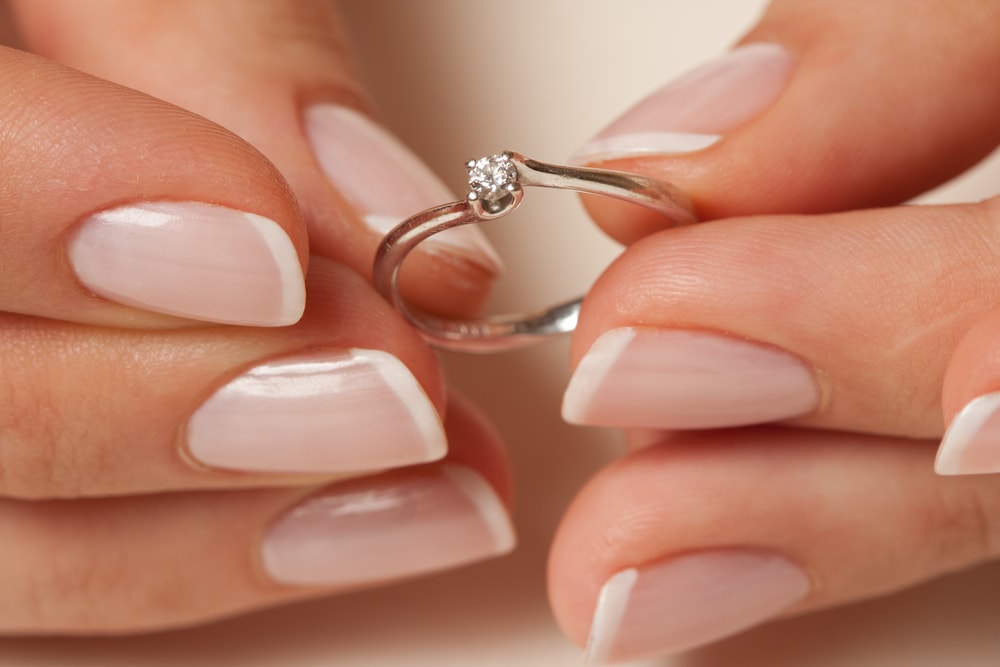
Table of Contents
As Jewelry Shopping Guide editors, we write about things that we love and we think you’ll like too. We often have affiliate partnerships, and may generate some revenue from these links at no cost to you.
When buying an engagement ring, one of the least considered factors is the width of the band. Most people tend to assume that there’s a standard width for engagement rings, but this isn’t the case. An engagement ring can range from minimalist and wiry to thick and chunky.
The type of band you choose depends on your preferences, budget and the ring style you’re after. Let’s take a look at everything you need to know about the width of your engagement ring.
What are the standard widths for engagement rings?
The width of a ring’s band is measured in millimeters and can range from 1mm to as wide as 20mm. However, the standard band widths most people go for range from 1.5mm or 2mm up to 6mm.
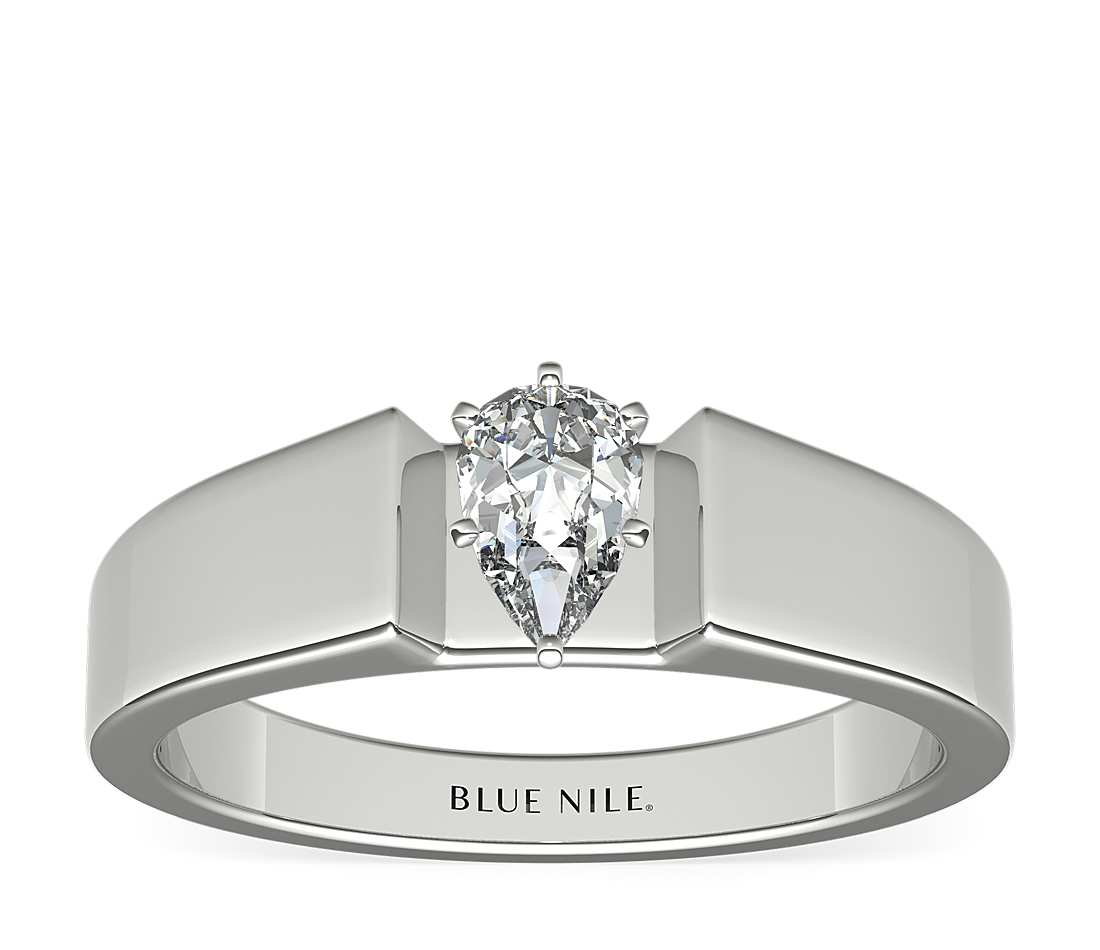
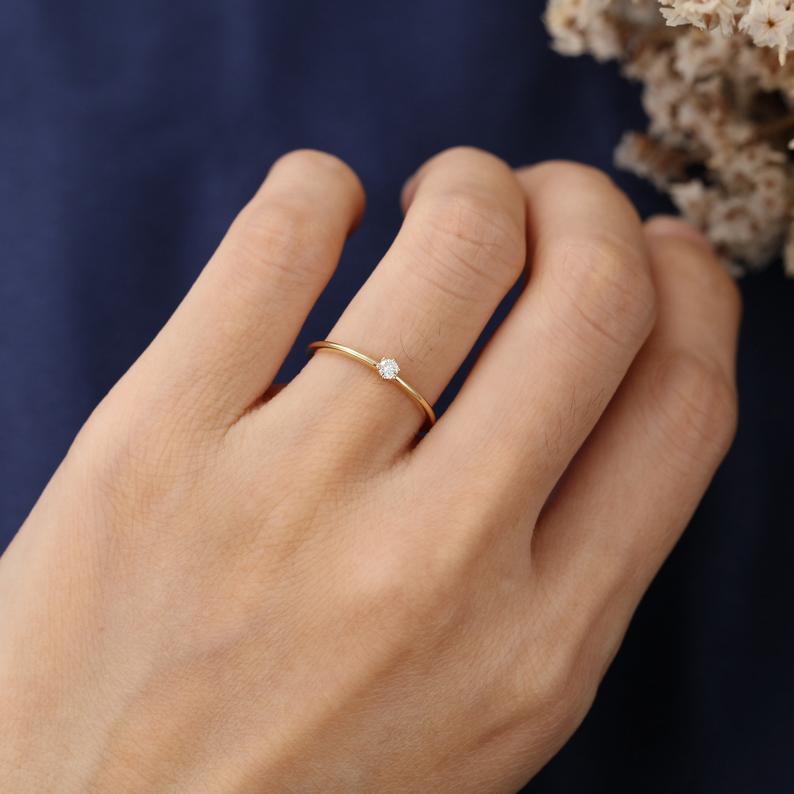
Anything wider than 6mm is “too wide” for most people in terms of appearance. On the other hand, bands thinner than 1.5mm are at risk of breaking too easily. In fact, a lot of jewelers will straight up refuse to make a ring that’s thinner than 2mm, especially if you insist on a metal that’s not durable enough.
Still, thinner bands do seem to be in style nowadays, as a lot of women find them to be more stylish – that’s why the lower end of the average standard is dropping below 2mm to 1.5mm.
Pros and Cons of wide and thin bands
To sum things up, here’s a quick list of the pros and cons of both thick and thin engagement ring bands:
Wide Bands
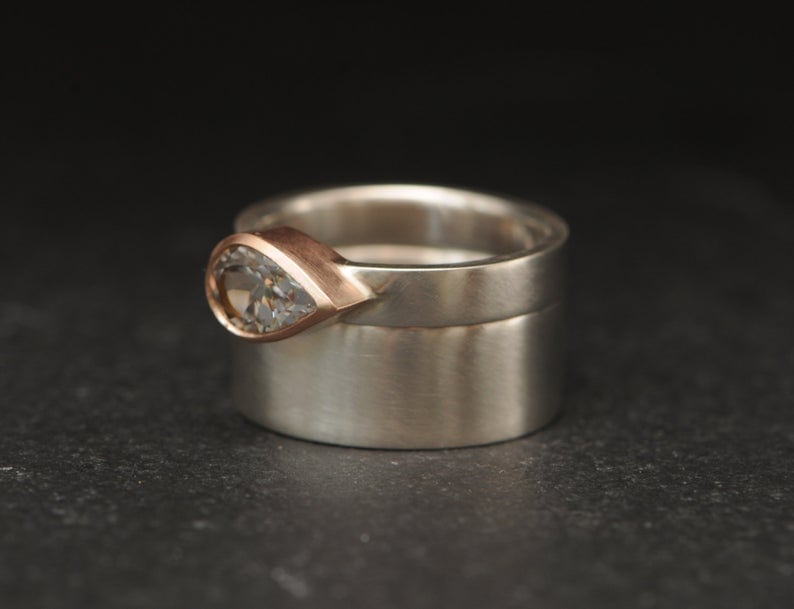
Pros of wide bands:
- Wide bands have a cool contemporary look.
- They work well with modest ring settings.
- They are extra sturdy and durable.
- Wider bands can be made of a larger variety of metals as they are inherently durable.
- Bands of at least a medium width can work well with larger and more complex halo or bezel settings, as well as deep channel settings that’d be difficult to install on really thin bands without compromising their structural integrity.
Cons of thick bands:
- More metal means a higher price for the overall ring. This can be offset if there are less luxurious settings on the ring, of course.
- Wider bands can be harder to fit on your finger because of their extra surface area so choosing a bigger size is advisable.
- Thick bands overwhelm small, thin fingers.
Thin Bands
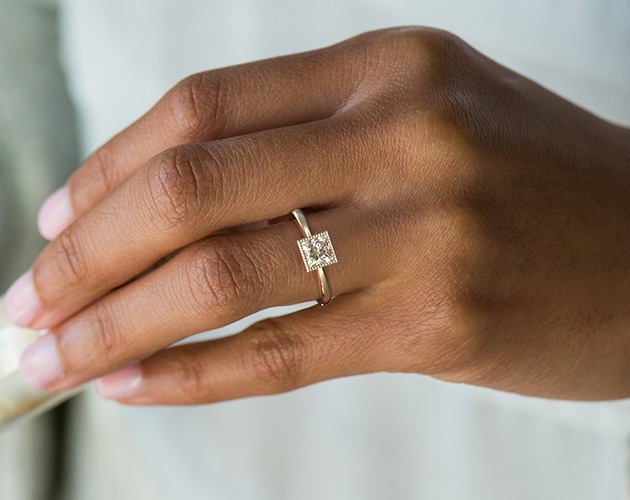
Pros of thin bands:
- Thinner bands sport a dainty and stylish look that’s more classically feminine.
- The less metal there is, the less expensive the overall band is going to be.
- They can make your centerpiece stone and sidestones look even more impressive.
- Thinner bands open more design choices such as bead bands or twisted eternity bands that’d be too impractical on a wider band.
- These bands fit more easily and are easier to resize.
Cons of thin bands:
- Thinner bands are less durable to direct impact and suffer more from wear and tear so choosing more durable materials for them is important.
- Extra-thin bands (<2mm) don’t work well with certain overly large and imposing settings such as halos.
- Channel, side-stone and pave settings are also trickier to install on a thin band as there’s less space to work with.
Does the band’s width affect how comfortably it fits?
If we’re talking about the standard width range of 2-6mm, we can safely say that it won’t affect how comfortably the ring fits. That’s because a millimeter is a really tiny unit of measurement so a difference of several millimeters doesn’t really make a ring “uncomfortable”.
Of course, if you suddenly switch from a 1.5mm ring to a 6mm one you will feel the difference at first, but you’re likely to get used to it quicky and it’ll become comfortable after a day or two.
Really wide bands over 15mm can be uncomfortable for a lot of people. For example, 20mm is 2 centimeters wide and a lot of people’s fingers literally can’t fit that between their knuckles.
How does band thickness impact a ring’s setting?
One of the key factors to choosing your engagement ring band width is the type of setting you’re going for. Most ring settings are simply incompatible with a thinner band – pave, side stone, and channel settings require a substantial width on the band, of at least 2mm or more if they are going to fit on it at all.
The size of the stone’s setting also matters since a halo or bezel setting that’s too big will not only look too large on an overly thin band but it might even present certain structural problems. If, however, you don’t want any channel or pave settings along the band and the centerpiece diamond and its setting are small in size, a thinner band can work.
Wide bands tend to be more minimalist in design, largely because they already have a statement look. They’re typically made of metal and may feature a few stones like this eye catching engagement ring.
Does the type of metal affect the band’s width?
It’s the other way around, actually – the band’s width can necessitate certain metal choices that you wouldn’t have otherwise considered.
Thinner ring bands, in particular, are always recommended to be crafted with sturdier metals that can better withstand the wear and tear of wearing a ring for several decades. Titanium and tungsten are all great choices for thin ring bands as they can make up for the missing millimeters and still ensure a long life for your engagement ring.
On the other hand, if you’re adamant that you want a gold or platinum ring, choosing a thicker band is a good idea as gold is rather soft and can easily bend if it isn’t thick enough. Another thing to consider is that gold can vary in its hardness and durability a fair bit – lower karats mean more foreign metals in the gold alloy which, in turn, means a harder gold alloy.
So, if you’re set on a thin gold band, at least drop down on the karatage, go with 14k gold or less instead of 18k or above. Also, it’s worth noting that rose gold is typically harder than yellow or white gold because of the copper in it making it a good choice.
Does the band width affect the shape and cut of the gemstone?
The shape and cut of the stone are mostly irrelevant to the band’s width, however, the stone’s size is a more important matter.
Not only will a large diamond look too much on an extra thin band but it will most likely be difficult to set on it and will compromise the ring’s integrity. If you’re working with a good jeweler they should tell you this upfront and warn you if the dimensions of the band and the stone don’t work well together.
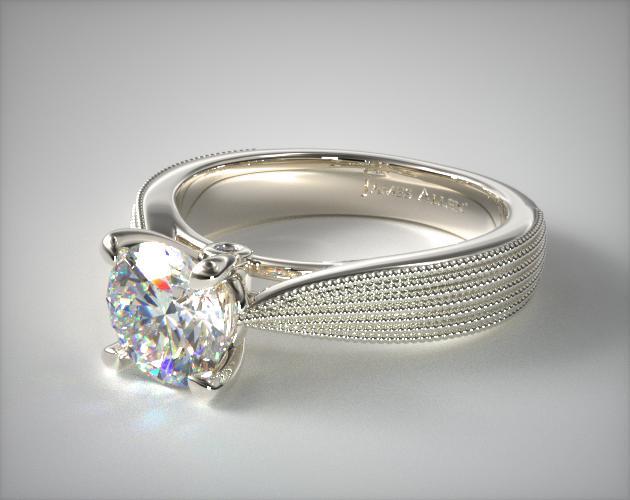
Conversely, a thick engagement ring band can make your center stone look smaller than it is, hiding its size and brilliance. To sidestep this issue, it’s best to opt for a tapered band. Tapered bands, like this white gold knife edge cathedral engagement ring, taper from a thick to a thin band as it nears the head of the ring, often moving at least 1.0mm down. With this style, you can have the benefits of a wide band and a thin band combined in one.
How to choose the band width to suit your hands
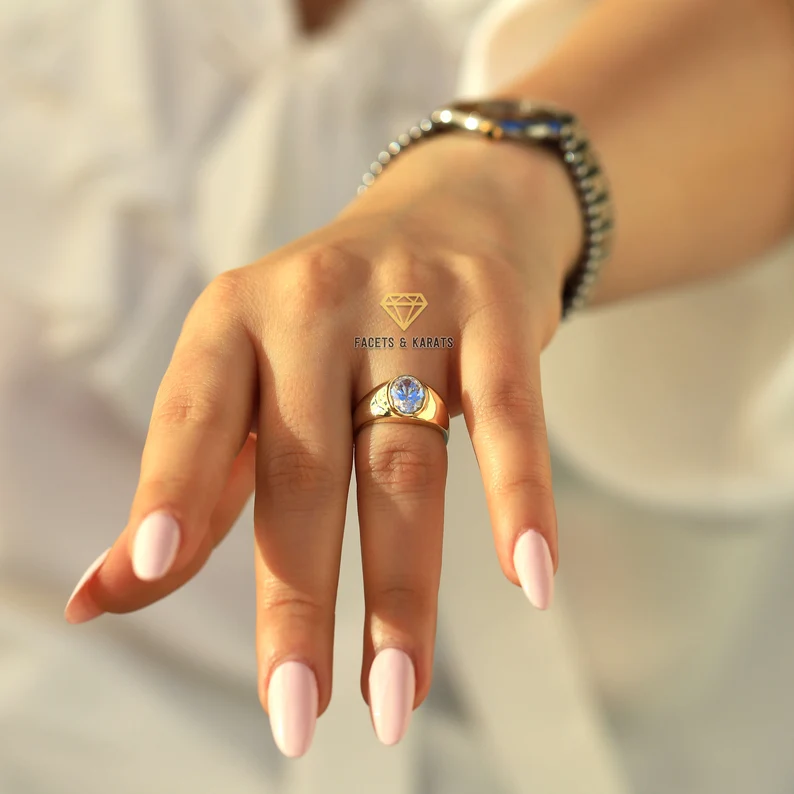
Aside from each of us having our own visual preferences, choosing between band widths is also a matter of finding the right physical fit for our hands and fingers. You may want a certain width for your engagement ring but if your hands and fingers aren’t suitable for it, it just won’t sit well.
So, how to choose the right width for your hands? Here are a few pointers:
- If you have tiny hands and/or thin fingers, choosing a wide and imposing band won’t sit well.
- If you have larger hands a wide band can look good on them.
- If your fingers and/or knuckles are wider, a thinner band will be easier to put on and take off than a wider band of the same diameter. That’s because wider bands have more surface area that has to be squeezed through which can be harder. This is also a valid consideration if you think your fingers are about to get wider.
- When choosing a wider band it’s important to pick it in half a size bigger than you otherwise would have so that it goes more comfortably through your fingers’ knuckles. Again, this is also important if your expect your fingers to grow wider.
- If you have sensitive skin then you don’t only need to choose the right metal but you’d also do well to avoid wider bands as their larger surface area can be more irritating.
How to protect a thinner band from damage?
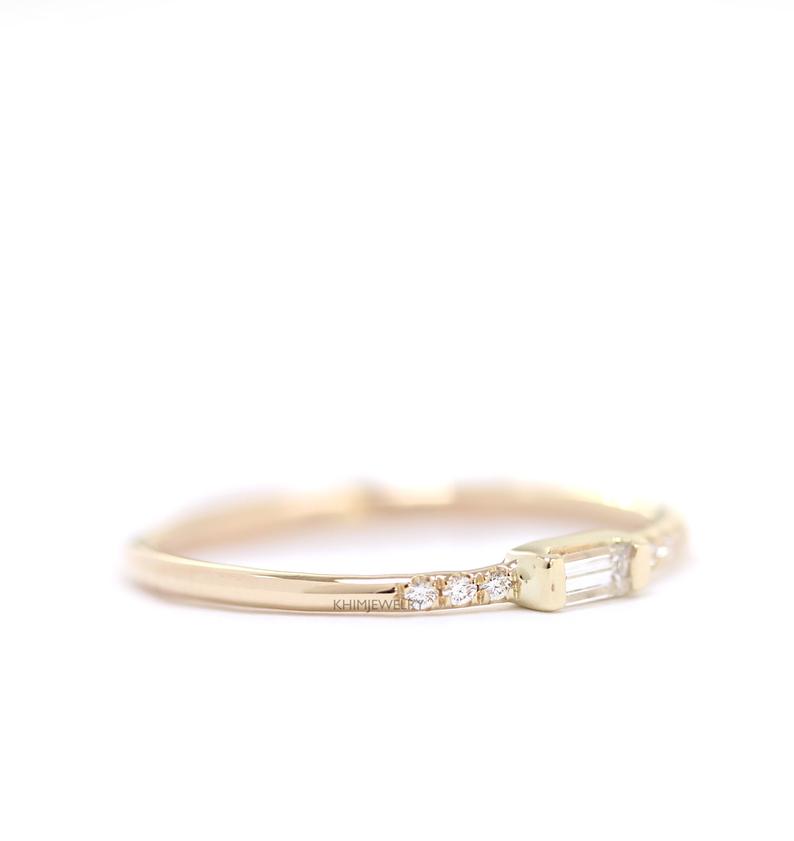
The main problems with thinner ring bands, as stylish as a lot of people find them to be, is that they are easy to break. They can be damaged by a single accidental blow or they can simply be ruined over time through wear and tear. So, to make sure that doesn’t happen you’ll need to be extra careful with your thin ring.
Unfortunately, there aren’t any specific steps you can take to protect thinner rings that you wouldn’t do for wider ones. All you can do is protect your ring from physical damage by taking it off before any type of manual labor or sport, clean your ring regularly and carefully, and bring it for annual inspections to your jeweler so that he or she may find potential problems early on. All this is important to do with any ring but more so for thinner bands. Another good idea for thinner rings is to consider jewelry insurance.









